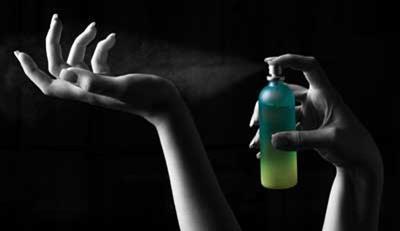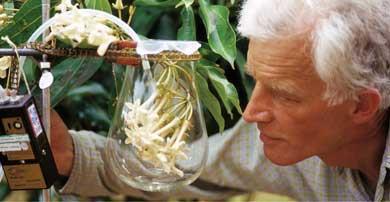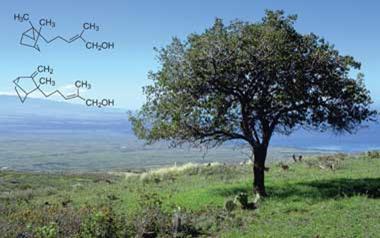Emma Davies pokes her nose into some of the world's most celebrated perfume molecules
Emma Davies pokes her nose into some of the world’s most celebrated perfume molecules
Philip Kraft designs molecules which elicit strong and immediate emotions in people. He creates new fragrances for Givaudan, a Swiss flavour and fragrance company, and some of his molecules play star roles in best-selling perfumes. He has the unusual skill that when he smells a compound, he can almost visualise its chemical structure. His work is driven by an obsession to create new molecules that will move people.

Kraft was drawn to fragrances and science at a very young age. As a 12-year-old with a desire to understand the science of teenage hormones, he bought a biochemistry textbook from his local university bookshop in Hamburg, Germany. A year later, his questions still unanswered, Kraft returned to buy a chemistry textbook. The shop assistant was most amused and gave him a test subscription to a chemistry journal - Liebigs Annalen der Chemie . Kraft was captivated by an article by Peter Weyerstahl, a fragrance chemist who had modified the odour of rose oxide. ’He had sent fragrance compounds to a company for evaluation so I wrote to that company and they sent me some materials, which I even used to give courses at school.’
Almost three decades on, Kraft is still entranced by fragrance molecules. He creates patent-protected ’captive ingredients’ for Givaudan to hold in its fragrance arsenal. The chemistry is challenging: ’It’s tough work and despite all the molecular design tools, you still have to be lucky,’ he says.
Scent search
Fragrance researchers search high and low for chemical inspiration. Givaudan, for example, runs its much-publicised ScentTrek missions to remote parts of the world to capture new smells.
The easily accessible fragrance ingredients were identified a long time ago, explains Koenraad Vanhessche, director of product and process research at Firmenich, another Swiss flavour and fragrance company. ’What is now happening is that we are looking at trace compounds - a lot of these have low thresholds or are relatively unstable.’

But much of the work is done by altering existing molecules, or by searching for commercially viable synthetic routes for known compounds. Kraft likes to follow a ’hardcore design approach,’ twisting, tweaking, and trimming existing molecules to modify odour and its intensity. ’When I smell an odour I can almost see the shape of the molecule. You look at the molecule, make a hypothesis as to why it smells like it does, and then test this hypothesis by modifying the molecule and seeing if you get the odour you desire,’ he explains. ’Often I make a molecule just to see how it smells.’
Kraft and his team frequently work on paper, sketching out molecular variations using ball and stick models. They also use olfactophore models, which show the molecular features that are key to a given odour, such as hydrophobic groups, and H-bond donors and acceptors. ’You can play with conformational elements that drive a certain molecular shape - for example you can introduce structural elements that cause a molecule to fold itself into a horseshoe shape and thus smell musky,’ explains Kraft. Adding rigidity to molecules often gives more defined odour notes, he adds. ’Or you can make the molecule more flexible to add new by-notes - you can cut some parts to make it lighter and more diffusive while conserving its overall shape.’
But his team sometimes takes the more traditional approach to creating captive ingredients. ’You can have chemical inspiration - you take known odour compounds and submit them to a specific series of reactions to see how the odour is modified. If you like something then you can follow up a certain aspect,’ says Kraft. Fragments of known fragrance molecules can also be incorporated.
Any new fragrance molecules created in the lab are assessed by perfumers. ’Sometimes it can be that a few love your molecule, while some hate it. If you love a certain molecule it can be frustrating if you see that other people don’t like it,’ says Kraft. Firmenich employs 67 perfumers. ’We have one very special person who is a chemist and also an excellent perfumer. He gets the feedback from his colleagues on what consumers want and interprets the information in olfactory tonalities,’ explains Toni Gautier, corporate vice-president of R&D at Firmenich.
When the perfumers take a liking to a new molecule, it’s often not long before new fragrances bearing the signature compound hit the high street. Looking back at perfume trends, it is clear when chemical breakthroughs have taken place in the industry, says Gautier.
Chart toppers
To make a fine fragrance, new molecules are mixed with old favourites. But which fragrance compounds are most valued by industry - a kind of fragrance top 10? It’s a difficult question to answer. Gautier has no doubt about the value of Hedione (methyl dihydrojasmonate), used in almost all fine fragrances and Firmenich’s top seller in terms of volume. The compound was discovered at Firmenichin the early 1960s as an analogue of methyl jasmonate, a key component of jasmine oil. Said to give a warm floral-jasmine note, Hedione has been used in perfumes for over 40 years, first starring in Dior’s Eau Sauvage in 1966.

’The synthesis of Hedione gives four stereoisomers,’ explains Gautier. ’Only one of them truly contributes to the odour - (+)-cis-methyl dihydrojasmonate - while the others are thought to modulate other fragrances. Over the years we’ve been able to synthesise new versions of Hedione which have a much higher quantity of the right isomer.’
Gautier also has a soft spot for the rose ketones: damascenone, and alpha and beta damascone. Firmenich is famed for their discovery and synthesis in the 1960s during a quest to identify the characteristic smell of Bulgarian rose oil. But batch purity problems meant that damascenone was not released commercially until 1982. Then came alpha-damascone (rose-apple note) and beta-damascone (blackcurrant-plum note). The rose ketones broke new ground in the 1980s, giving female perfumes such as Dior’s Poison their unusual and distinctive fragrance. Today, beta-damascenone and beta-damascone remain two of the most important fragrance ingredients.
Chemists are forever improving on the rose ketones, which are still trendsetters. One of Kraft’s recent and ’very successful’ captives is Pomarose, a ’cut-open’ seco-damascone. Pomarose introduced the dried-fruit character of Poison to the male market and had its debut in DKNY’s male fragrance Be delicious Men . ’It has a very specific note of cooked apple, rose, and dried plums. It’s very diffusive so it gives a lot of bloom to a fragrance,’ enthuses Kraft. Givaudan’s process development team had to try 19 different synthesis routes before it managed to produce Pomarose. ’Initially we thought we couldn’t produce it. It was a crazy idea that originated from a 1 per cent impurity for which different structures were proposed based on the NMR spectrum. After we had discovered the correct structure we synthesised the "wrong proposal" for fun but it turned out to be so powerful,’ recalls Kraft. Interestingly, it wasn’t the impurity itself that became Pomarose, but one of the alternative structures.
Pomarose was recently used in high concentrations in Unforgivable man by Sean Jean - also known as US rapper P Diddy - who is said to have been quite taken with the compound’s champagne-like qualities.
Another essential - and once controversial - group of flavour compounds is the macrocyclic musks, which are extremely important to the industry, says Gautier. Musks once had a bad name, in the days when they were derived from the musk pods of the Asian musk deer. These days, musk odourants are all synthetic. ’Replacing the musk ingredients caused something of a stir but the industry is probably better off now because it has biodegradable ingredients with no environmental effects,’ says John Leffingwell of flavour and fragrance consultants Leffingwell and associates.
Musks belong to several classes that are structurally very different. Those synthesised by the industry are generally nitro musks, polycyclic musks and macrocyclic musks. Gautier would like to add Helvetolide, a linear musk discovered by Firmenich in 1990, to the ’most-valued’ list. Helvetolide had a totally different structure to existing musk compounds and its discovery opened up a whole new domain of musk chemistry, says Gautier. Together with macrocyclic musks, Helvetolide is key to ’white musk’ compounds, said to be reminiscent of freshly ironed linen. These are currently very fashionable, says Kraft.
Out of the woods
Woody fragrances such as Iso E Super, a compound known as a ’floraliser’ and used in most new fine fragrances, also rate highly, says Gautier. Some people smell a cedarwood note in Iso E Super, while others perceive it to be musky. The male fragrance Fahrenheit (Dior, 1988) is 25 per cent Iso E Super while Perles de lalique (Lalique, 2007) is 80 per cent Iso E Super. The commercial Iso E Super owes its woody smell to a 5 per cent impurity which has an odour threshold about 100 000 times lower than that of the main product.

In 1999, Kraft’s team at Givaudan isolated this impurity by epoxidation of a commercial Iso E Super and proposed a structure based on NMR spectra. The team came up with a way to synthesise the compound but it was not commercially viable and the structure turned out to be too complex for an alternative synthetic procedure. But out of several synthesised analogues, one had an almost equal odour threshold and smelled even better. What is more, its industrial synthesis is straightforward and it has become a big hit - used by Givaudan as the captive material Georgywood.
However, on strictly cash terms, the most valuable fragrances are the natural products. For example, East Indian sandalwood oil is one of the most precious and expensive perfumery raw materials.
Beta-santalol is the main olfactory constituent of sandalwood oil. It wasn’t until 1990 that beta-santalol could be prepared in the lab - this took an 11-step reaction that was unsuitable for industrial scale-up. The best sandalwood oil substitutes are derivatives of alpha-campholenic aldehyde, prepared from inexpensive alpha-pinene, most of which is a byproduct of the paper industry.
’The components in sandalwood oil are not easy to make,’ acknowledges Gautier. ’But what Firmenich has done is screened all around that kind of structure to try to find woody notes. We have a lot of substitutes so that perfumers can create something close to sandalwood without needing sandalwood oil.’ Kraft agrees that there are ’excellent synthetic substitutes’ out there. For example, the campholenic aldehyde derivatives typically have a good sandalwood smell. ’The other olfactory parts of natural sandalwood oil - such as the smokey, cedar-like aspects - can easily be added using, for example, cedarwood oil,’ says Kraft.
Sandalwood was initially quite cheap (Guerlain’s Samsara contained 25 per cent sandalwood) but overharvesting has led to Indian sandalwood trees being listed on the World Conservation Union’s threatened species red list.
’There’s still a good market for sandalwood oil and the price has gone, in the past six or seven years, from $1000 [?680] per kg to over $2000,’ says Leffingwell. One Australian firm, TFS Corporation, has taken the initiative and planted over 1700 hectares of the endangered Indian sandalwood (Santalum album ) in plantations in Western Australia.
After sandalwood comes the hippy favourite - patchouli oil. Its fragrance comes largely from patchoulol. ’It’s a truly unique ingredient that is ideal for perfumes. But it is a molecule that we have not been able to make cost-effectively by synthesis. So this is one of the holy grails of organic synthesis - to find a route to make patchoulol,’ says Gautier.
Firmenich works with farmers to cultivate research crops, one of which is patchouli, grown in Indonesia. ’It is of extreme importance to the industry that we are able to improve any way of making this product - be it by organic synthesis or plant cultivation, improvement of the strains, and extraction from the plant,’ says Gautier.
Finally, there’s nootkatone, a key ingredient in grapefruit, and much valued for today’s light and fruity perfumes. This, says Leffingwell, is a very expensive chemical that can currently only be synthesised from a byproduct from the citrus industry, which is in short supply. Only one of its isomers has the grapefruit odour ((+)-(4R,4aS,6R )-nootkatone)). The other, (-)-(4S,4aR,6S )-nootkatone, is very weak, with almost no grapefruit character.
Perfume challenge
The perfume industry is also facing new challenges from regulators, particularly from the EU, which is limiting the use of possible allergenic compounds in perfumes. Current legislation means that fine fragrance producers have to declare on packaging if a perfume contains any of a list of 26 ’allergens’. Leffingwell thinks that there’s a risk that before long fragrance producers won’t even be able to use orange oil and lemon oil (these contain limonene, which at high concentrations can cause a skin reaction). ’It’s ridiculous. If you took all these things away from the perfumer they’d have real difficulty making nice fragrances,’ he says.

But the industry is reacting in a positive way. ’Our clients would prefer not to have allergens on the label so in a lot of cases we are now generating fragrances that don’t have the compounds in them,’ says Gautier.
’It is a bit more difficult when clients want you to take these molecules out of existing perfumes without having any change. We do have replacers but they are not exactly equivalent. To have the same organoleptic, physical and economic properties is a challenge.’
There is also the issue of biodegradability. Fragrance chemists have to be careful to keep the molecular building blocks for fragrances relatively inert. ’We try to avoid reactions in the perfume. Most of the compounds are carbonyl compounds. If the pH is neutral you don’t get aldol reactions so we don’t use a lot of acids in fragrances
except a few for honey notes,’ says Kraft.
A few years ago, the perfume industry ran into problems because its molecules were too inert and didn’t biodegrade, recalls Kraft. ’Now we’re going back to make them biodegradable. It’s a challenge to make them stable enough that they don’t decompose in the perfume itself.’
Fickle fragrance
The demand for new fragrance compounds is driven by today’s consumers, who are always on the lookout for something different. Unlike 30 years ago, the life of a perfume today is relatively short. ’In many cases now a fragrance will be very popular for a year or two, then the consumers move on,’ explains Lefingwell.
Since 2000, over 5000 new perfumes have been introduced, says Michael Edwards, who compiles the book Fragrances of the world , commonly described as the perfume bible. He thinks that customers are confused. ’Why do all fragrances smell alike?’ he asks. ’The problem is that product managers want as broad an audience as possible. If you go for broad appeal it’s very hard to come up with a fragrance that has got guts and signature.’ He thinks that the industry doesn’t need to search perpetually for new compounds. ’We’re not using the great materials that we already have imaginatively enough. Look at Iso E Super, first used in 1975 and now becoming a star in its own right. It’s really a case of imagination over raw materials.’
From what I’ve seen, it’s imagination that leads to new materials. And there’s no stopping the fragrance chemist in the addictive search for the next ’hit’ and the ensuing public reaction. Asking them to stop what they’re doing would be like asking the Rolling Stones to stop performing. ’Perfumery can be very gratifying because, as with music, you create a real effect - you can create sensuous moments for people,’ says Kraft. ’My mother doesn’t understand any chemistry but with a smelling strip containing one of my molecules she can feel the chemistry of the molecule.’
Emma Davies is a science writer based in Bishop’s Stortford, UK






No comments yet